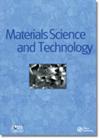高宽高比TiO2-Mn3O4异质结构:精通病原体抑制和超级电容器应用的纳米棒
IF 2.2
4区 材料科学
Q3 MATERIALS SCIENCE, MULTIDISCIPLINARY
引用次数: 2
摘要
由于清洁和可持续能源的需要,超级电容器的需求量很大。另外,水传播的微生物感染是疾病的主要原因。因此,需要合成具有多功能适应性的新型材料。本文采用两步法合成了异质结构TiO2-Mn3O4复合纳米棒。首先采用静电纺丝法制备TiO2纳米棒,并通过水热法将Mn3O4纳米颗粒附着在TiO2表面。利用x射线衍射、傅里叶变换红外光谱、扫描电子和透射电子显微镜等复杂的方法对复合异质结构进行了描述。对革兰氏阴性大肠杆菌和革兰氏阳性金黄色葡萄球菌进行了抗菌研究。结果表明,TiO2 - mn3o4复合材料比原始TiO2具有更高的抗菌活性。此外,合成的TiO2-Mn3O4复合材料被认为是超级电容器的电极。在电位扫描速率为5 mV/s时,TiO2-Mn3O4纳米复合材料的确定电容放大至470 Fg−1。本文章由计算机程序翻译,如有差异,请以英文原文为准。
High aspect ratio TiO2–Mn3O4 heterostructure: proficient nanorods for pathogen inhibition and supercapacitor application
ABSTRACT Supercapacitors are in great demand owing to necessity of clean and sustainable energy. Alternately, waterborne microbial infections are prime cause of diseases. So, there is demand for synthesis of novel materials with multifunctional adaptability. Herein, heterostructured TiO2–Mn3O4 composite nanorods were synthesised by two-step methods. In first step, TiO2 nanorods were prepared using electrospinning and by hydrothermal method Mn3O4 nanoparticles were attached to TiO2 surface. The composite heterostructure was described using sophisticated procedures such as X-ray diffraction, Fourier transforms infrared spectroscopy, Scanning electron and Transmission electron microscopy. Antimicrobial studies were probed against Gram-negative Escherichia coli and Gram-positive Staphylococcus aureus pathogens. The results demonstrated that TiO2–Mn3O4 composite has more heightened antimicrobial activity than pristine TiO2. Additionally, the synthesised TiO2–Mn3O4 composite was implied as an electrode for supercapacitors. The definite capacitance of TiO2–Mn3O4 nanocomposite calculated at a potential scan rate of 5 mV/s was as amplified as 470 Fg−1.
求助全文
通过发布文献求助,成功后即可免费获取论文全文。
去求助
来源期刊

Materials Science and Technology
工程技术-材料科学:综合
CiteScore
2.70
自引率
5.60%
发文量
0
审稿时长
3 months
期刊介绍:
《Materials Science and Technology》(MST) is an international forum for the publication of refereed contributions covering fundamental and technological aspects of materials science and engineering.
 求助内容:
求助内容: 应助结果提醒方式:
应助结果提醒方式:


